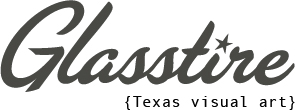Contemplating the art of Arielle Masson is a cosmic journey that spirals through deep inner space into the vastness of the universe — moving through the past and towards the future.
Inspired by her inner visions, as well as mathematics and the geometry of nature, Masson’s surreal paintings and prints, on view at Houston’s Glassell School of Art, respond to our contemporary world. In Ingenious, we see the abomination of genetically engineered creatures: a turtle mixed with a cat, a lion cloned with an alligator. In a recent interview, Masson said this is the “carrot of progress,” the false promise of technology, which “does not always deliver happiness or what humanity needs.”
This theme is reflected in works such as Upgraded-Blue Wave, depicting a whale skeleton trapped in an elegant modernist structure, as well as, Return to the Invisible Landscape, with alarming wave patterns emanating from, or pointing towards, the contaminated red surf and black clouds of a toxic oil spill in the Gulf.

Arielle Masson, “Return to the Invisible Landscape,” 2011, egg tempera and oil on canvas on panel, 24 x 24 inches
The show’s title, Chaotic Nodes, is taken from a vision she had while meditating. “A chaotic node happens when the collective creations of the mind achieve an existential paroxysm of absurdity, manifesting itself as a tear in the fabric of reality,” she says in a written statement.
One interpretation of this vision is a large mural titled Rabbit-Hole, painted in brown and black on the gallery wall, with vibrating waves emanating from, or leading into, what could be a hole in the universe, a glimpse into another reality, or an interior world.

Arielle Masson, “Tocsin Intervention,” 2020, gouache and transfer on watercolor paper, 12 ¼ x 12 ¾ inches
Alarms and warnings are a vital aspect of this body of work, which dates from 2004 to 2024. We see multiple interpretations of the 2019 burning of the Notre Dame cathedral in Paris, several of them titled Tocsin, which is the name for bells ringing in alarm.
We also see multiple visions of “interventions” or “intrusions” featuring unidentified flying objects. In conversation, she poses two questions about UFOs. Are they signaling to us something about physics and technology? Or are they religious, like angels, looking down at us and the world we are destroying?
Masson might be this outsider, sending us signals — warning us about our world. She thinks of herself as an outsider, she says. Her mother was Mexican and her father was French. Born in Mexico, she grew up in Brussels, studying art, literature, and linguistics at the Sorbonne in Paris. She received an MFA from the University of Houston and then a Core Fellowship at the Glassell School, where she has been teaching painting and drawing since 1990. In 1994, she also studied at Project Row Houses with Texas Southern University mathematician Robert Powell, who was an influence on the late, great Houston artist and muralist John Biggers.
Her visual vocabulary draws on mathematics and includes chains, strings, lattices, spirals, stars, and overlapping circles known as vesica piscis. One may also find the ancient and the modern in her subject matter: towers, reactors, spaceships, mountains, clouds, pyramids, birds, bugs, and rivers.
Masson makes her own paint, mixing ancient materials and techniques with her contemporary paintings and prints such as rabbit skin glue and marble dust, “The oldest way of making paintings,” she says. Her thought-provoking exhibit is the first in a series showcasing the art faculty at the Glassell School of Art.
Chaotic Nodes is on view through Oct. 6 at the The Glassell School of Art at the Museum of Fine Arts, Houston.






